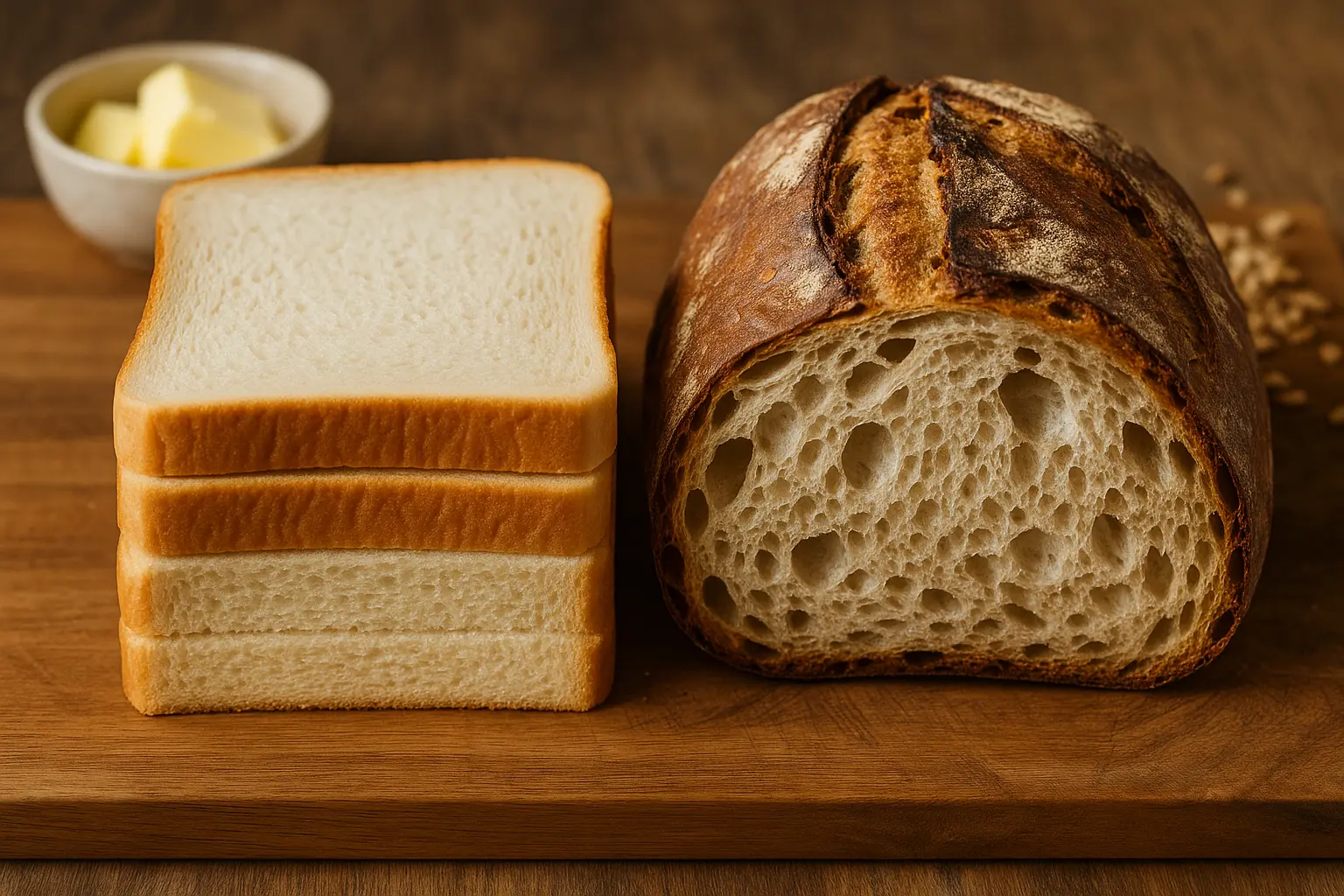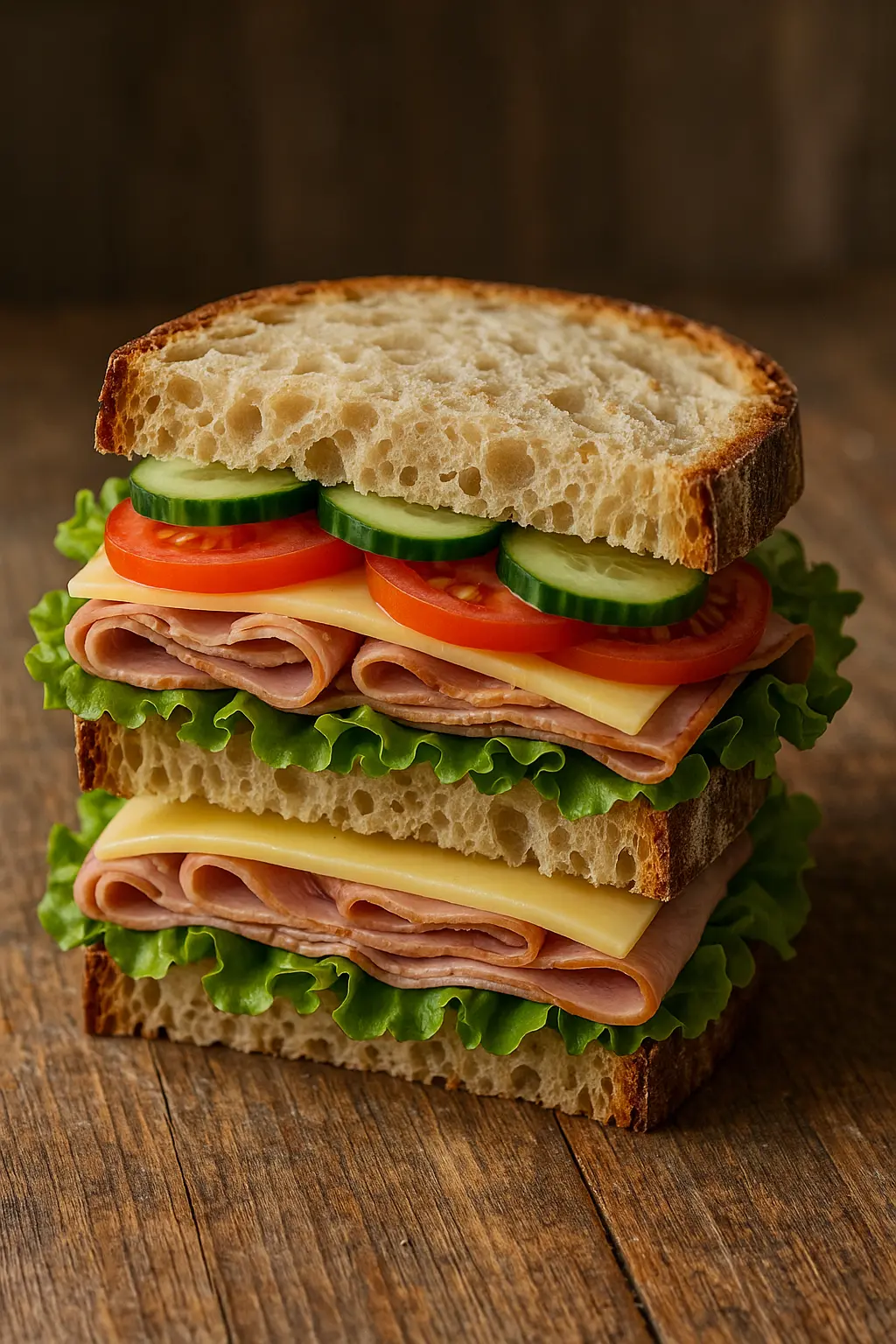Introduction
When you’re standing in the bread aisle wondering what really separates sandwich bread from regular bread, you’re not alone. The subtle and not-so-subtle differences can influence everything from texture to taste, and even how long your bread stays fresh. Understanding the ins and outs of sandwich bread vs regular bread can elevate your sandwich game and help you make better baking and buying choices. Whether you’re craving a soft slice or an artisanal crust, this guide dives deep.
If you want an overview of sandwich bread, you’ll find it interesting how their characteristics vary compared to other types of bread. Or, if artisan bread piques your interest, check out the health aspects and benefits of artisan bread.
Defining Sandwich Bread and Regular Bread
What is Sandwich Bread?
Sandwich bread is often thought of as the classic, square-shaped, neatly sliced loaf perfect for stacking your favorite fillings. It’s designed especially for convenience: soft crumb, light texture, and perfect size for everyday use. This bread usually contains ingredients like yeast, milk, and butter to produce a tender, pliable slice. Popular for quick sandwiches, it’s also often commercially made to have a longer shelf life thanks to added emulsifiers and dough conditioners.
Want to see a recipe showing how to make a soft and fluffy bread? It’s a fun way to understand the bread-making process that results in bread softness.
What is Regular Bread?
Regular bread, also known as artisan or rustic bread, tends to be less processed and often handmade or baked in smaller batches. It can include a wide variety of bread types: sourdough, ciabatta, baguettes, and more. These breads are characterized by a denser bread crumb, thicker bread crust, and diverse textures. They emphasize traditional baking techniques, fewer additives, and natural fermentation. The flavor often has complexity from longer fermentation times, but this comes with a typically shorter bread shelf life.
Check out this soft and tender homemade loaf to see regular bread with sandwich uses.

Key Differences Between Sandwich Bread and Regular Bread
Texture and Structure
One of the most noticeable differences in the sandwich bread vs regular bread debate is texture. Sandwich bread has a very soft, uniform crumb designed to be pliable and hold sandwich fillings without falling apart. Its airy and delicate structure makes it easy to bite through, ideal for kids’ lunches or fast meals.
In contrast, regular bread typically has a more irregular and denser crumb. The bread density varies significantly, and you may notice large air pockets, giving it a chewy or rustic feel. This texture provides a heartier bite.
If you’re curious about the detailed science behind texture, explore the bread making process, which explains how different kneading and fermentation methods impact softness and crumb.
Crust Characteristics
When considering bread crust, sandwich bread has a thin, soft crust almost blending seamlessly with the interior. This makes it easier to chew and less likely to crumble.
Regular bread’s crust is usually thicker, crunchier, and often darker due to baking techniques and longer baking times. This crust forms a signature feature of artisan breads, adding bread flavor and textural contrast.
Ingredient Composition
Sandwich bread ingredients often include added sugars, milk, fats like butter or oil, and commercial bread additives such as emulsifiers and dough conditioners to enhance softness and bread preservation. This combination creates the signature tender crumb and longer freshness.
Regular bread tends to use simpler ingredients: flour, water, yeast, and salt. Some artisan breads might incorporate natural starters and whole grains but avoid additives, leading to a more natural, sometimes tangy flavor.

Flavor Profile
The flavor difference is noteworthy. Sandwich bread usually has a mild, slightly sweet taste due to milk and sugar, making it a versatile base that doesn’t overpower fillings.
Regular or artisan breads deliver a complex, sometimes nutty or sour flavor developed from fermentation and baking methods. This bold flavor can complement or contrast sandwiches uniquely.
Shape and Practical Design
Practically, sandwich bread is baked in pans producing uniform, square slices that fit well in sandwich makers and lunchboxes. This convenience is a major selling point.
Regular bread shapes vary wildly — from round boules to long baguettes — which can be trickier to slice uniformly but offer aesthetic and sensory variety.
Preservation and Shelf Life
Shelf life comes down to formulation and packaging. Sandwich bread contains preservatives and additives to maintain softness and inhibit mold growth, often lasting a week or more unrefrigerated.
Regular breads lack these preservatives and spoil faster, typically best consumed within a few days. However, their natural composition appeals to purists.
For tips on ways to extend bread shelf life, check out expert advice on preserving freshness.
Health Considerations: Sandwich Bread vs Regular Bread
Nutritional Differences
Is there a health gap between sandwich bread vs regular bread? Sandwich bread often contains enriched flour and added sugars, with a softer texture but may have fewer nutrients compared to whole-grain artisan breads. On the other hand, regular breads, especially whole grain or sourdough types, pack more fiber, vitamins, and minerals.
That said, some sandwich bread brands offer whole grain or reduced sugar options — it’s all about reading labels.
Additives and Preservatives Impact
Additives like dough conditioners and preservatives extend shelf life and texture but have stirred debate about their long-term effects. Regular bread’s minimal ingredients appeal to those seeking cleaner labels and fewer processed items.
Explore this artisan vs commercial bread health comparison for more detail.
Using Regular Bread for Sandwiches: Pros and Cons
Suitability of Regular Bread in Sandwich Making
Can you use regular bread for sandwiches? Absolutely! It adds character and often holds up well with robust fillings. However, its irregular shape and denser crumb might make for a messier sandwich experience compared to classic sandwich bread.
Examples of Artisan Breads Used for Sandwiches
Common picks include ciabatta, focaccia, baguettes, and sourdough loaves. These breads bring unique flavors and textures but may not suit every filling. For ideas, visit simple bread sandwich ideas.
Types of Bread Best Suited for Different Sandwiches
Classic Sandwich Bread Varieties
White sandwich loaves, whole wheat, and multigrain versions dominate here — soft, mildly flavored, and evenly sliced. Favorites in school lunches and deli counters, they deliver consistent results. To explore varieties perfect for your meal, see this guide on varieties perfect for your meal.
Specialty Breads for Sandwiches
Artisan breads like rye, sourdough, and olive bread bring bold elements to sandwiches, perfect for gourmet stacks or bold fillings. These breads can elevate the taste experience but generally have a shorter shelf life and a stronger flavor.
How to Choose the Right Bread for Your Sandwich
Factors to Consider: Texture, Flavor, Durability
Choosing bread isn’t rocket science but think about texture: do you want a soft, pillowy base or a chewy, crunchy bite? Flavor matters, too — subtle or bold? Then consider durability: will your sandwich be eaten immediately or packed for later?
Matching Bread Type to Filling Type
Pair light, soft breads with delicate fillings like turkey or cucumber, and match denser, flavorful breads with robust meats and cheeses. Need some inspiration? Check out tips on choosing bread for sandwiches for perfect pairings.
FAQs
Is sandwich bread the same as white bread?
Not exactly. While sandwich bread is often white bread, it’s specifically baked to be softer, sliced uniformly, and made with ingredients like milk and sugar to enhance softness and bread shelf life. White bread can be any basic loaf made from white flour. Sandwich bread is a subset optimized for convenience and texture.
What makes sandwich bread different from regular (artisan/real) bread?
The key differences lie in the bread texture (soft and uniform vs. dense and varied), bread crust (thin and soft vs. thick and crusty), ingredients (presence of additives in sandwich bread), and bread shelf life (longer vs. shorter). Sandwich bread prioritizes practicality, while regular bread focuses on flavor and traditional baking.
Which is healthier, sandwich bread or regular bread?
Generally, regular bread, especially whole grain or sourdough, tends to be healthier due to fewer additives and more natural ingredients, providing more fiber and nutrients. However, whole grain sandwich breads can be a healthy choice. Always check labels for sugar and preservative content.
Can you use regular bread for sandwiches?
Yes! Many artisan breads make excellent sandwiches, bringing robust flavor and texture. The only caveat is their irregular shape and denser crumb, which may affect sandwich integrity, but creativity shines here. For ideas, explore simple bread sandwich ideas.
Why does sandwich bread stay fresh longer?
Its longer freshness comes from bread additives like emulsifiers and preservatives, and packaging that maintains moisture. These ingredients prevent staling and mold, allowing sandwich bread to remain soft and edible longer than typical artisan loaves.
Conclusion
Sandwich bread differs from regular bread mainly in texture, ingredient makeup, flavor, and shelf life. Crafted for convenience, sandwich bread provides softness, pliability, and longer freshness tailored for classic sandwiches. In contrast, regular or artisan bread spotlights traditional baking techniques, richer flavors, and diverse textures but often with a shorter shelf life and denser crumb. Your choice boils down to whether you prioritize ease and longevity or crave authentic texture and complex flavors. Understanding these distinctions empowers you to pick the perfect bread for your culinary adventures.

1 thought on “Sandwich Bread vs Regular Bread: Key Differences Explained”